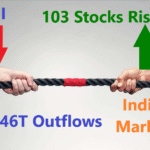Equity markets’ strong performance over the past five years may have created a false sense of security among new investors. Discover strategies to overcome challenges and remain focused on achieving long-term investment goals in 2025.
How Investors Can Navigate 2025’s Market Challenges and Stay on Track
Equity markets dominated investor sentiment throughout 2024, even as volatility surged due to a series of global events. From geopolitical tensions to weaker-than-expected economic growth, disappointing corporate earnings, and foreign portfolio investor (FPI) outflows, the year was eventful and unpredictable. As we step into 2025, the investment landscape remains challenging, making strategic financial planning more important than ever. Here’s what investors should focus on to secure their long-term financial goals.
Key Challenges Ahead for Investors in 2025
The year 2025 brings several challenges that could dampen market sentiment. These include:
- A slowdown in corporate earnings growth.
- Persistent inflationary pressures affecting purchasing power.
- Geopolitical instability contributing to economic uncertainty.
- Higher U.S. bond yields and a stronger dollar driving capital outflows.
- Continued FPI selling and concerns over potential U.S. tariff changes.
Such factors make it essential for investors to reevaluate their strategies and prepare to tackle the hurdles ahead. While navigating these challenges may seem daunting, adopting a disciplined, long-term approach can help investors stay on track toward their financial objectives.
Step 1: Evaluate Risk-Taking Ability vs. Risk-Taking Capacity
Many investors, particularly those who entered the markets over the last five years, have only experienced bullish trends and quick returns. This has created a false sense of confidence about risk-taking. However, risk-taking capacity (financial ability to absorb losses) is very different from risk-taking willingness (emotional readiness for short-term volatility).
Investors must introspect if they can remain calm during periods of high volatility. It’s important to ask:
- Can they handle short-term losses without panicking?
- Are they prepared for the illiquidity associated with some investments?
Only investors with a truly long-term horizon should consider taking on higher risks. Those focusing solely on short-term gains may find themselves overwhelmed by market fluctuations.
Step 2: Ensure Your Portfolio Beats Inflation
It’s not enough for your investments to earn nominal returns; they must deliver inflation-beating growth to preserve and grow wealth. Many households still rely heavily on traditional investments, like fixed deposits and insurance plans, which offer low returns. For example:
- A portfolio with just 10% equities and 90% traditional investments (yielding an average of 5.5% per year) generates a weighted return of 6.05%.
- With inflation at 6%, such a portfolio barely breaks even.
- Even a portfolio with 25% equity exposure outpaces inflation by just 0.75%.
To achieve meaningful wealth creation, investors need to allocate at least 30-40% of their portfolio to equities. This shift ensures higher growth potential over the long term, even if short-term volatility persists.
Step 3: Focus on What You Can Control
While market performance is beyond an investor’s control, key factors such as the investment amount, time horizon, and asset allocation are entirely within their reach. Instead of chasing quick returns, investors should prioritize disciplined, consistent investing over time. Historical data provides compelling evidence:
- The 10-year rolling returns (as of November 30, 2024) for the Nifty Midcap 150 Index stood at 16.02% annually.
- Similarly, the Nifty Smallcap 250 Index delivered 13.33% annually over the same period.
Over the long term, investment returns tend to average out, making the amount invested more critical than chasing short-term gains. For example:
- Investing ₹15,000 monthly with an annual return of 18% can grow to ₹70 lakhs in 10 years.
- Comparatively, investing ₹25,000 monthly with a 12% return can grow to ₹84 lakhs in the same period.
It’s not necessary to begin with large investments immediately. Incrementally increasing the investment amount every year can also help build significant wealth over time. For instance:
- A ₹15,000 monthly SIP at 12% annual returns can grow to ₹4.62 crore in 30 years.
- With a 10% annual step-up in investment amount, the corpus can grow to ₹11.97 crore by the end of 30 years.
Smart Financial Moves to Build Wealth and Reduce Debt in 2025
In 2025, navigating personal finances requires strategic planning and disciplined decision-making. From managing debt efficiently to avoiding unsustainable financial temptations, adopting the right financial habits can dramatically impact your long-term wealth. Here’s a comprehensive guide to help you take control of your finances, reduce debt burdens, and avoid common pitfalls.
Pay Extra EMIs to Reduce Debt Faster
For individuals with outstanding loans, particularly home loans, paying an extra EMI (Equated Monthly Installment) every year can significantly reduce the total interest paid over the loan tenure and help achieve debt freedom sooner.
For instance, consider a ₹50 lakh home loan with a 20-year tenure. By paying a single extra EMI each year, borrowers can eliminate up to 25 scheduled EMIs over the loan period. This reduces both the interest outgo and the repayment timeline, providing financial relief in the long run.
Debt management is critical because loans, while accessible, can become a long-term financial burden. The temptation to borrow for aspirational purchases through “buy now, pay later” schemes, personal loans, or salary advances is high. However, as an unknown financial expert once said, “Credit buying may feel rewarding immediately, but the long-term consequences can outweigh the benefits.” Taking small, mindful steps like paying additional EMIs can go a long way toward reducing financial stress.
Avoid the Perils of Easy Credit and Loans
The rise of easy-to-access credit in recent years has made it tempting for many to fund aspirations with borrowed money. However, over-reliance on loans can lead to a cycle of debt. Financial experts suggest taking a step back and challenging yourself to avoid unnecessary financing options like:
- Buy Now, Pay Later (BNPL): While convenient, BNPL schemes can lead to overspending and hidden interest costs.
- Salary Advances: Borrowing against future earnings can create a cash flow imbalance.
- Personal Loans: High-interest personal loans often result in significant repayment obligations.
By resisting these temptations, individuals can focus on building wealth rather than servicing debt. A disciplined approach to spending and borrowing is essential for long-term financial stability.
Be Wary of Financial Advice on Social Media
Social media platforms have become a popular source of financial advice, but not all recommendations are reliable. A recent study revealed that over 70% of stock recommendations from financial influencers, or “finfluencers,” failed to generate profits. While content like “best mutual funds to invest in” or “systematic withdrawal plans” gained traction in 2024, much of it relied on unsustainable or overly optimistic assumptions.
Relying on short, attention-grabbing videos for investment decisions can be risky. Instead, seek guidance from credible sources, such as certified financial advisors or thoroughly researched publications. Avoiding impulsive decisions based on social media trends can save you from potential losses.
The Power of Discipline and Small Changes
Real, enduring financial change doesn’t require drastic measures—it can begin with simple, consistent actions. Here are some steps to consider:
- Increase Your Savings Contributions Gradually: If you’re starting with a small investment amount, commit to increasing it annually. A SIP (Systematic Investment Plan) with a 10% yearly step-up can significantly boost your corpus over time.
- Focus on Debt Repayment: Prioritize clearing high-interest loans first, followed by long-term debt like home loans.
- Stay Informed: Rely on established, credible resources for financial advice rather than unverified online content.
The Path Forward
Investors in 2025 face a complex and uncertain environment, but a disciplined approach can help overcome challenges. Start by evaluating your risk tolerance, ensuring your portfolio outpaces inflation, and focusing on factors you can control. Over time, these strategies will help you achieve your long-term financial goals, even amid market volatility.
Stay tuned for the next steps and insights to keep your investments on track. Remember, success in investing isn’t about reacting to market noise — it’s about staying consistent and focused on your goals.
The Bottom Line
Achieving financial success in 2025 requires a combination of smart debt management, mindful spending, and informed decision-making. By paying extra EMIs, avoiding unnecessary loans, and steering clear of unreliable financial advice, you can reduce financial stress and build a secure future.
Remember, the key to long-term wealth creation lies in discipline, patience, and focusing on what’s within your control. As the saying goes, “Small steps today can lead to big changes tomorrow.” Start taking those steps now, and you’ll be on your way to financial freedom.











